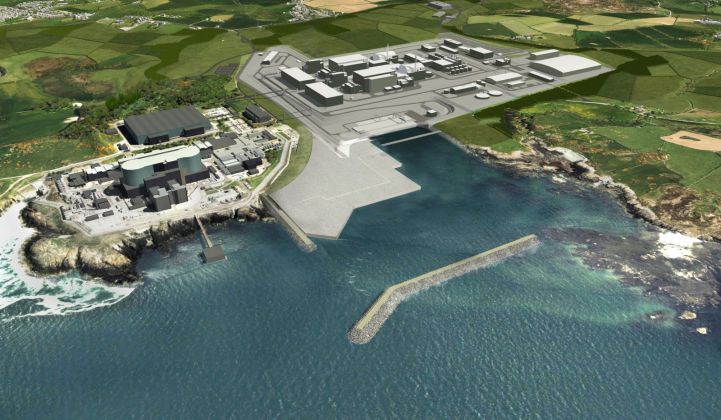Hitachi has confirmed it is walking away from a proposed new nuclear power plant in the U.K., raising serious questions about government plans to fund new nuclear projects.
Speculation began earlier this week but has finally been confirmed by Hitachi on Wednesday.
The Wylfa Newydd project in Wales was put on pause by Hitachi in January 2019 after its subsidiary, Horizon Nuclear Power, said it could not secure financing. The company was also eyeing a site at Oldbury in England. The projects had a combined capacity of 5.8 gigawatts.
Now that pause on Wylfa is permanent.
The U.K. government told GTM it had offered to take equity, provide all the debt finance and back a revenue stabilizing mechanism.
The U.K. has 9 GW of nuclear power capacity, most of which will be retired in the early 2030s. EDF is currently building Hinkley Point C, which will add another 3.2 GW in the middle of this decade. It has a contract for difference (CFD) at a strike price of £92.50 per megawatt-hour ($121.90) for 35 years.
EDF’s Sizewell C is also waiting for confirmation over a possible new funding model, with an equally generous CFD off the table. There is currently no government-backed route to market for new nuclear plants in the absence of any nuclear CFD. Entirely private financing attempts have stalled, leaving the government's proposal to add a levy to consumer bills the only game in town.
Wylfa had already entered the national infrastructure planning process; its application deadline was at the end of this month. The Oldbury project was at a more nascent phase of development.
“Nuclear power has a critical role to play in helping to tackle our energy needs, meeting our climate change targets and leveling up the economy through green growth and job creation,” said Horizon CEO Duncan Hawthorne in a statement confirming the news.
“Wylfa Newydd...and Oldbury...are highly desirable sites for new nuclear build. We will do our utmost to facilitate the prospects for development which will bring the major local, national and environmental benefits that nuclear can uniquely deliver as we push to transition to a net-zero carbon economy by 2050,” he added, suggesting that a new developer could take over the site and pick up where Horizon has left off.
No clarity on future funding plans
In August this year, Horizon stated publicly that it could ramp up progress on Wylfa very quickly if required. Hawthorne told the Financial Times: “We are ready to go...but the funding model needs to be in place. We've got a competitively priced project that will generate jobs quickly and really fuel the economy in the region the plant is in.”
Horizon had set its hopes on a U.K. government consultation process to consider a regulated asset base (RAB) model to fund new nuclear power plants through consumer power bills. A (highly regulated) levy would be handed to developers, including during the construction phase, which helps keep the cost of financing down. It's a model used for other infrastructure markets, including London's £5 billion "super sewer" tunnel. Critics argue it can leave consumers on the hook for the construction risk.
The RAB consultation closed in October 2019. In May the U.K.’s Department for Business, Energy and Industrial Strategy (BEIS) told GTM that the results of the consultation would be published in due course. There is still no progress four months later. It appears that BEIS had no update for Horizon in August that was sufficient to persuade them to maintain their interest in new-build nuclear in the U.K.
A government spokesperson said nuclear continued to have a "key role" in the U.K. energy mix.
"That’s why we previously offered a significant package of potential support to this project that went well beyond what any government has been willing to consider in the past," they said in a statement. "This included taking a one-third equity stake, providing all of the required debt financing to complete construction, and providing generous financial support through our Contract for Difference scheme."
“We remain willing to discuss new nuclear projects with any viable companies and investors wishing to develop sites in the U.K., including in North Wales.”
Despite all that on the table, Hitachi walked away.
Emma Pinchbeck, CEO of trade body Energy U.K., noted that most credible advice on the country’s route to hitting its 2050 net-zero target includes nuclear power. That includes projections by the Committee on Climate Change, the government's official climate advisory board.
“We would welcome further clarity from the government on its nuclear strategy, including a decision on a funding model for new nuclear in the U.K.,” she said in a statement.
The China General Nuclear Corporation owns 33.5 percent of Hinkley Point C and 20 percent of Sizewell C, a proposed duplicate of the new Hinkley plant. It also has the majority stake in the Bradwell B project, which it has ambitions to build itself, rather than merely acting as an investor.
Further potential investment from Chinese state-owned companies has drawn the ire of politicians, including former Conservative Party leader Iain Duncan Smith, warning against the wisdom of China’s dominance in new nuclear in the U.K.
If BEIS is not comfortable with the RAB model, the last obvious funding option would be for the government to fund the construction itself, rather than outsourcing it to French and Chinese state-owned companies.




